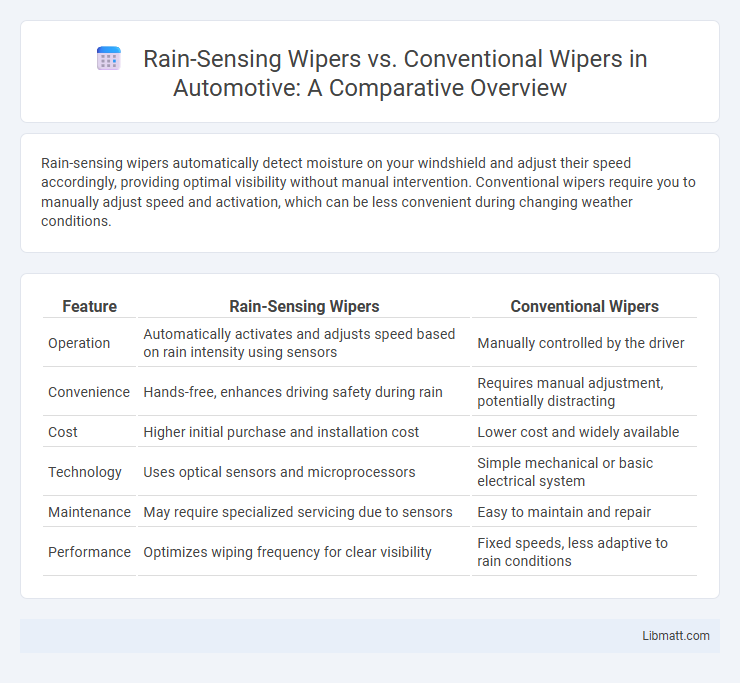Rain-sensing wipers automatically detect moisture on your windshield and adjust their speed accordingly, providing optimal visibility without manual intervention. Conventional wipers require you to manually adjust speed and activation, which can be less convenient during changing weather conditions.
Table of Comparison
| Feature | Rain-Sensing Wipers | Conventional Wipers |
|---|---|---|
| Operation | Automatically activates and adjusts speed based on rain intensity using sensors | Manually controlled by the driver |
| Convenience | Hands-free, enhances driving safety during rain | Requires manual adjustment, potentially distracting |
| Cost | Higher initial purchase and installation cost | Lower cost and widely available |
| Technology | Uses optical sensors and microprocessors | Simple mechanical or basic electrical system |
| Maintenance | May require specialized servicing due to sensors | Easy to maintain and repair |
| Performance | Optimizes wiping frequency for clear visibility | Fixed speeds, less adaptive to rain conditions |
Introduction to Windshield Wiper Technologies
Rain-sensing wipers utilize advanced optical sensors to detect moisture on the windshield and automatically adjust the wiper speed for optimal visibility, offering improved safety and convenience compared to conventional wipers. Conventional wipers rely on manual operation, requiring drivers to engage or adjust wiper speed based on weather conditions. The integration of rain sensors marks a significant advancement in windshield wiper technology, enhancing real-time response to varying rainfall intensities.
How Rain-Sensing Wipers Work
Rain-sensing wipers use optical sensors to detect moisture on the windshield, automatically adjusting the wiper speed based on the intensity of the rainfall. These sensors emit infrared light that is reflected back from the glass, with the amount of reflected light varying according to the presence of water droplets. Conventional wipers require manual operation, lacking the ability to dynamically respond to changing weather conditions.
Conventional Wipers: Manual Operation Explained
Conventional wipers require manual activation and speed adjustment, relying on the driver to respond to changing weather conditions. These wipers typically have a simple control lever allowing you to turn them on or off and select intermittent, slow, or fast speeds. Unlike rain-sensing wipers, conventional models do not automatically detect rain, making your vigilance essential for safe driving in wet conditions.
Key Differences Between Rain-Sensing and Conventional Wipers
Rain-sensing wipers use advanced sensors to detect moisture on your windshield and automatically adjust their speed for optimal visibility, while conventional wipers require manual activation and speed control. The sensor technology in rain-sensing wipers enhances driving convenience and safety by responding promptly to changing weather conditions without driver intervention. Conventional wipers lack this automation, making rain-sensing wipers a more sophisticated and efficient solution for managing rain on your windshield.
Advantages of Rain-Sensing Wipers
Rain-sensing wipers automatically detect moisture on the windshield, providing optimal wiping speed and frequency without manual adjustment, enhancing driver convenience and safety. These systems reduce driver distraction by activating only when necessary, ensuring clear visibility under varying weather conditions. Compared to conventional wipers, rain-sensing wipers improve response time and preserve wiper blade life by minimizing unnecessary use.
Benefits of Conventional Wipers
Conventional wipers provide reliable and straightforward performance, offering consistent control over blade speed and timing based on your manual input. They are less expensive to repair or replace compared to rain-sensing wipers, making them a cost-effective option for many drivers. Your ability to adjust the wiper settings according to specific weather conditions ensures personalized visibility and safety while driving.
Common Issues and Maintenance
Rain-sensing wipers often face issues like sensor malfunction and delayed activation, requiring regular cleaning of rain sensors and software updates. Conventional wipers commonly suffer from blade wear and streaking, necessitating frequent blade replacement and arm adjustment. Proper maintenance of both systems includes checking for debris buildup, ensuring blades are intact, and verifying correct wiper operation to maintain optimal visibility and safety.
Cost Comparison: Installation and Upkeep
Rain-sensing wipers typically involve higher initial installation costs due to advanced sensors and integration with your vehicle's electronic systems, while conventional wipers are more affordable and straightforward to install. Maintenance expenses for rain-sensing wipers can also be greater, as sensor calibration and potential electronic repairs may be required, whereas conventional wipers mostly need regular blade replacements at a low cost. Choosing rain-sensing wipers enhances convenience and safety but requires consideration of these elevated installation and upkeep costs compared to conventional options.
User Experience and Convenience
Rain-sensing wipers enhance user experience by automatically detecting moisture on the windshield and adjusting the wiper speed accordingly, eliminating the need for manual control. This convenience allows you to focus more on driving safely without distractions from adjusting wiper settings. Conventional wipers require manual activation and speed adjustment, which can interrupt your attention during changing weather conditions.
Which Wiper System Is Right for You?
Rain-sensing wipers automatically adjust their speed based on the intensity of rainfall, providing hands-free operation and improved visibility during changing weather conditions. Conventional wipers require manual control, offering a reliable and cost-effective solution for drivers who prefer simplicity and direct control. Choosing between rain-sensing and conventional wipers depends on your driving habits, budget, and preference for convenience versus control.
Rain-sensing wipers vs Conventional wipers Infographic

 libmatt.com
libmatt.com